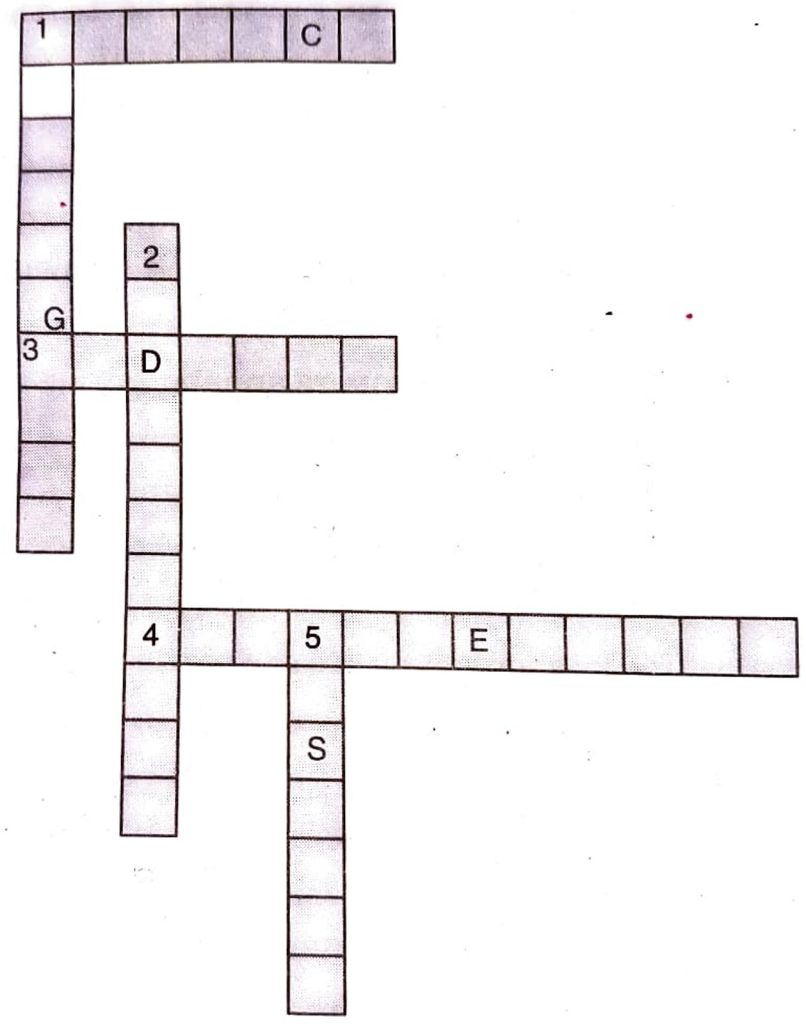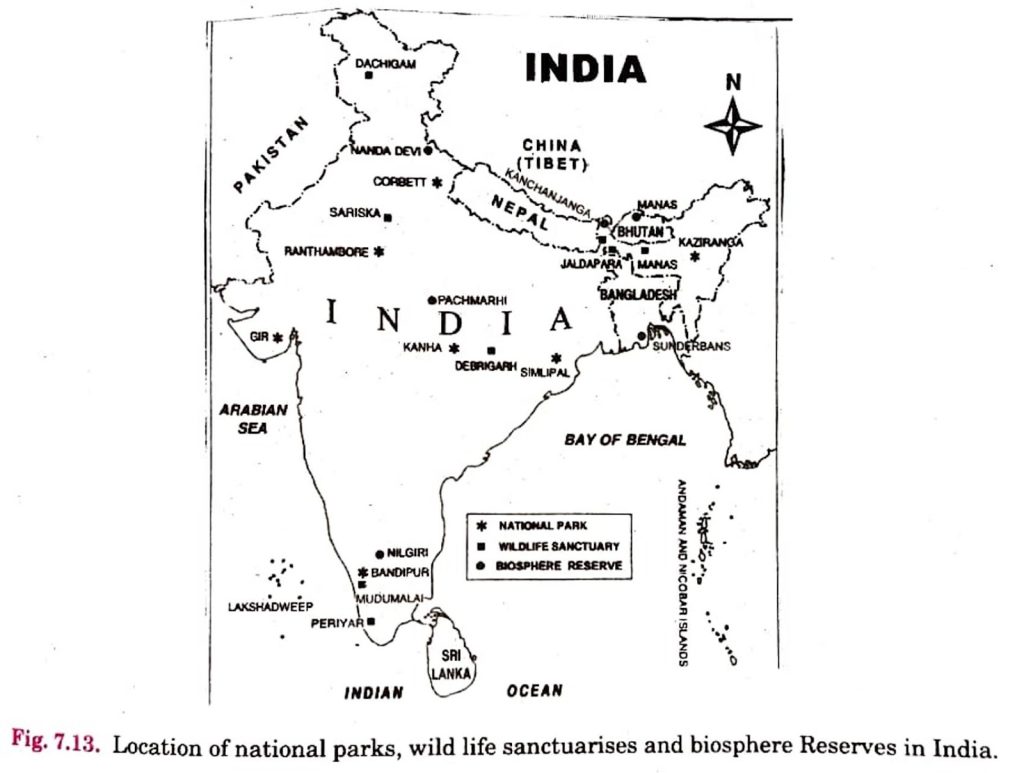NCERT Class 8 Science Chapter 7 Conservation of Plants and Animals Solutions to each chapter is provided in the list so that you can easily browse through different chapters NCERT Class 8 Science Chapter 7 Conservation of Plants and Animals and select need one. NCERT Class 8 Science Chapter 7 Conservation of Plants and Animals Question Answers Download PDF. NCERT Class 8 Science Solutions.
NCERT Class 8 Science Chapter 7 Conservation of Plants and Animals
Also, you can read the NCERT book online in these sections Solutions by Expert Teachers as per Central Board of Secondary Education (CBSE) Book guidelines. CBSE Class 8 Science Solutions are part of All Subject Solutions. Here we have given NCERT Class 8 Science Chapter 7 Conservation of Plants and Animals and Textbook for All Chapters, You can practice these here.
Conservation of Plants and Animals
Chapter: 7
NCERT TEXT BOOK EXERCISES
Q. 1. Fill in the blanks:
(a) A place where animals are protected in their natural habitat is called _________.
Ans. wildlife sanctuary.
(b) Species found only in a particular area is known as __________.
Ans. endemic species.
(c) Migratory birds fly to far away places because of _________ changes.
Ans. climate.
Q. 2. Differentiate between the following:
(i) Wildlife sanctuary and biosphere reserve.
Ans.
| Wildlife sanctuary | Biosphere |
| 1. A wild-life sanctuary occupies a comparatively smaller area of land. | 1. A Biosphere Reserve is spread over a very large area of land. |
| 2. A wildlife sanctuary is mainly for the protection of wild animals of the area in their natural habitat. | 2. A Biosphere Reserve is for the conservation of biodiversity of the area as well as the economic development of the area. |
(ii) Zoo and wildlife sanctuary.
Ans.
| Zoo | Wildlife Sanctuary |
| 1. In a zoo, the wild wild animals and birds live in artificial settings such as cages and enclosures. | 1. In a wildlife sanctuary, animals and birds live in their natural habitat in the forest. |
| 2. A wildlife sanctuary contains wild animals and birds found locally. | 2. A zoo contains wild animals and birds brought from the different parts of the country and from various other countries of the world. |
(iii) Endangered and extinct species.
Ans.
| Endangered species | Extinct Species |
| 1. The species which are facing the risk of extinction are called endangered species. | 1. The species which no longer exist any where on the earth are called extinct species. |
| 2. Examples: Snow leopard, Asiatic lion, Desert cat. | 2. Examples: Dinosaur, Cave lion, Caspian tiger. |
(iv) Flora and Fauna.
Ans.
| Flora | Fauna |
| 1. The plants of a particular area called Flora of that area | 1. The animals of a particular area are called Fauna of that area. |
| 2. The Flora of pach-marhi biosphere reserve are: Sal, Teak, Mango, Jamun etc. | 2. The Fauna of panch-marhi biosphere are chinkara, blue bull, barking deer, cheetal, wild dog etc. |
Q. 3. Discuss the effects of deforestation on the following:
(a) Wild animals.
Ans. Wild animals: Plants and trees are the habitat and food for wild animals. So deforestation destroy the natural habitat of wild animals and thus they would become endangered species.
(b) Environment.
Ans. Environment: Deforestation decreases the level of oxygen in the atmosphere. Rainfall and the fertility of soil also decreases due to deforestation. As a result, there are increased chances of natural calamities like floods and droughts.
(c) Villages (Rural areas).
Ans. Villages (Rural areas): Deforestation will cause soil erosion making the soil infertile and lead to desertification. The removal of the top layer of soil during soil erosion, exposes the lower, hard and rocky layer of soil. This lower layer of soil has less humus and it is less fertile. Villagers will not get fruits, fuel, or wood due to deforestation.
(d) Cities (Urban areas).
Ans. Cities: Deforestation does not affect the life of cities directly. Deforestation affects climatic conditions of the area. Calamities like floods and droughts do not spare cities.
(e) Earth.
Ans. Earth: Deforestation affects the earth worstly. The fertile land of the earth is converted into deserts and its temperature rises. It changes its climate and environment.
(f) The next generation.
Ans. The next generation: Many beautiful fauna and flora are destroyed due to deforestation. So, the next generation will not be able to see them.They will not have a clean and healthy environment.
Q. 4. What will happen if:
(a) We go on cutting trees.
Ans. If we go on cutting trees, then:
(i) Ecological balance is disturbed.
(ii) Earth will loose up top fertile layer and converted into desert.
(iii) Floods and droughts will become more frequent.
(iv) Many animals lose their shelters.
(v) There will be scarcity of things like fruits, paper which we get from forests.
(b) the habitat of an animal is disturbed.
Ans. Animals become unprotected and unconserved when the habitat of animal is disturbed. It becomes endangered.
(c) the top layer of soil is exposed.
Ans. Top layers of soil are fertile if it is exposed it loses its fertility and humus. It causes desertification.
Q. 5. Answer in brief:
(a) Why should we conserve biodiversity?
Ans. We should conserve biodiversity to save plants and animals from extinction.
(b) Protected forests are also not completely safe for wild animals. Why?
Ans. The protected areas are not completely safe for wild animals because the poaching takes place on a large scale in these areas. The poachers kill wild animals in those protected area.
(c) Some tribals depend on the jungle. How?
Ans. Some tribals depend on the jungle for their area. food, clothes, shelter and other requirements.
(d) What are the causes and consequences of deforestation?
Ans. Causes of deforestation: Due to changing lifestyle of the people and development of technology, the utilization of forest products has increased tremendously. The main causes of deforestation are:
(i) Requirement of more timber for housing purposes due to increase in population.
(ii) Clearing the forest land for cultivation.
(iii) Construction of roads and dams.
(iv) Overgrazing by the cattle.
(v) Increased mining industry.
Consequences of Deforestation:
(i) Deforestation will cause an increase in temperature on earth’s atmosphere leading to global warming.
(ii) Deforestation will cause soil erosion making the soil infertile and lead to desertification.
(iii) Deforestation will cause frequent flooding of rivers leading to loss of life and property.
(iv) Deforestation affects the water cycle leading to decrease in rainfall. The decrease in rainfall lowers the ground water level and could cause droughts.
(v) Deforestation leads to the extinction of many wild animals and plants.
(vi) Deforestation will lead to a shortage of wood and other forest products.
(e) What is a Red Data Book?
Ans. Red Data Book: Red Data Book is the book which keeps a record of all the endangered animals, plants and other species. The first Red Data Book of animals was published in 1991.
Through this book, IUCN (now WCU) is trying to create awareness about the endangered species.
(f) What do you understand by the term migration?
Ans. Migration: The seasonal movement of animals from one habitat to another to overcome unfavorable conditions is called migration. Animals migrate between their wintering and breeding habitats.
Q. 6. In order to meet the ever-increasing demand in factories and for shelter, trees are being continuously cut. Is it justified to cut trees for such projects? Discuss and prepare a brief report.
Ans. The continuously cutting of trees is not justified for any project. We do not only cut the trees, we destroy the habitats of many animals, birds and other organisms. The ecological balance is also disturbed. It also causes many natural calamities such as floods and droughts.
Q. 7. How can you contribute to the maintenance of green wealth of your locality? Make a list of actions to be taken by you.
Ans. We can contribute to the maintenance of green wealth of our locality by the following actions:
(i) We should grow more and more trees on the other side of the road.
(ii) We should discourage the cutting of trees.
(iii) The government should make laws to prevent the excessive cutting of trees.
(iv) Parks should be made in a particular area.
Q. 8. Explain how deforestation leads to reduce rainfall.
Ans. Trees emit a large amount of water in form of water vapour during transpiration. Depletion of water vapour affects cloud formation and results in less rain fall.
Q. 9. Why should paper be saved? Prepare a list of ways by which you can save paper.
Ans. We should save paper:
(i) to save forest trees from being cut down.
(ii) to save water used in paper making.
(iii) to save energy (electricity) used in making paper. and
(iv) To reduce the amount of harmful chemicals used in paper making.
Ways of Saving Paper:
(i) Write on both sides of a paper.
(ii) Reuse the paper.
(iii) Leave less margin.
(iv) Make toys, caps etc., out of used papers.
Q. 10. Complete the word puzzle:
Down
1. Species on the verge of extinction.
2. A book carrying information about endangered species.
5. Consequence of deforestation.

Across
1. Species which have vanished.
2. Species found only in a particular habitat.
4. Variety and variability of a plant, animal and microorganisms.
Ans.

Q. 11. Find out about the national parks in your state. Identify and show their location on the outline map of India.
Ans. See Map.


Hi! my Name is Parimal Roy. I have completed my Bachelor’s degree in Philosophy (B.A.) from Silapathar General College. Currently, I am working as an HR Manager at Dev Library. It is a website that provides study materials for students from Class 3 to 12, including SCERT and NCERT notes. It also offers resources for BA, B.Com, B.Sc, and Computer Science, along with postgraduate notes. Besides study materials, the website has novels, eBooks, health and finance articles, biographies, quotes, and more.



